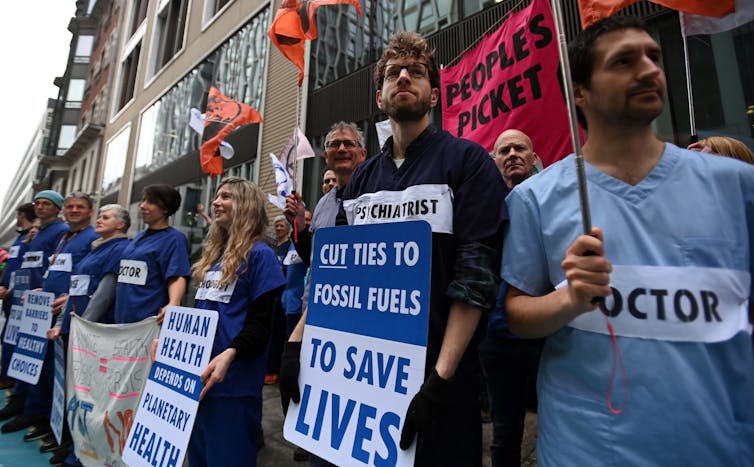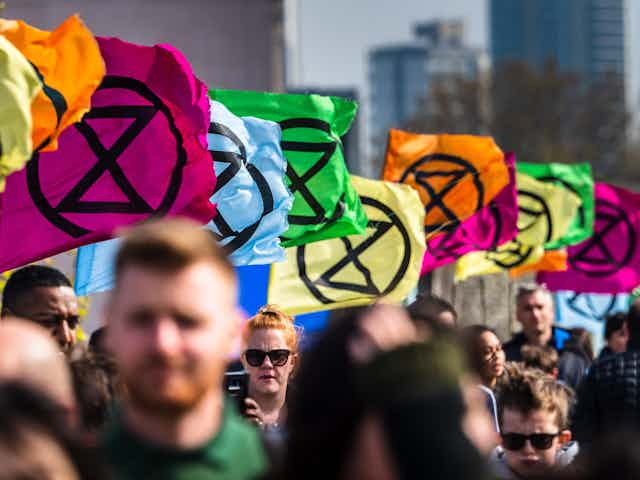The banners have been packed away, the face paint washed off and the Instagram accounts updated. The latest four-day demonstration by environmental protest group Extinction Rebellion (XR) – dubbed “the Big One” as it aimed to be the largest climate protest in UK history – ended without a single arrest.
The movement that began with civil disobedience in 2018 has now declared its preference for “attendance over arrest and relationships over roadblocks”. Four months ago, the group announced a pause on disruptive action that inconvenienced the public, such as road blockades.
On a long weekend between April 21 and 24, that commitment was put to the test as tens of thousands (how many tens is something I will come back to) of people filled streets in London – especially around government buildings.
Giving up disruptive action that could lead to arrest (and arguably bad headlines) will have helped XR get organisations like the Fairtrade Foundation on their side. To attract the widest possible support, talk of “rebellion” was removed from the publicity material.
Through February and March, I and others on XR’s mailing list received multiple emails announcing that the coalition supporting the Big One was growing, with more and more non-governmental organisations signalling their support (and presumably encouraging their own members to get involved).
Alongside this, experienced activists cautioned about the excited rhetoric of transformational change and the dangers of drawing analogies with the protests that led to the break up of the Soviet Union in the late 80s and early 90s.
The numbers game
This non-disruption tactic worked to gather a big crowd. I’ve seen crowd estimates ranging from 30,000 to 100,000. XR’s estimate, and the one widely reported, is 60,000. That puts the Big One on par with the 2019 climate strike as the UK’s joint biggest environmental protests.
But the numbers on their own are not what we should focus on. There are two strategic questions after a big demonstration, at least in my opinion. First, what is now more difficult for the subjects of the demonstration? In this case, what can the government no longer do, or only do at increased political cost.
And second, what new capacities do the organisers and participants of the protest have that they can soon deploy to further raise those costs on the government?

It’s hard to see how the UK government, committed as it is to further licensing North Sea oil and gas exploration (using carbon capture and storage as a cover), is meaningfully constrained by the London protests.
And now that XR has followed through on its promise to pause disruption in order to form relationships (or at least have dialogue) with organisations that had perhaps previously regarded it as too radical, it’s hard to imagine these organisations changing tack.
More likely, it’s XR that will become more mainstream. It’s an old story: the organisation that has come to shake things up finding, relatively quickly, that it is trapped in a necessary web of expectations and obligations.
Indeed, the claim that, according to environmental magazine The Ecologist, “as many as 80% of XR protesters voted to amp up future campaigning using civil disobedience and non-violent direct action – including supporting picket lines” may create tensions and splits within XR about what counts as disruption.
Will XR “build relationships” to show that it is not a threat? Or will it build relationships with those locked in related struggles with the government, like striking workers? Nothing was finally decided at the Big One – both paths lie open.

Ultimately, I’m reminded of the umbrella organisation Stop Climate Chaos that formed in 2005. By 2009, all that its diverse membership could agree on (and this after much negotiation) was a march called the Wave which happened in December to coincide with the UN climate summit in Copenhagen.
The numbers on that march? In the same ballpark as the Big One: about 50,000 people. And after the Wave there was only a trickle, for many years.
What next?
After the Big One, XR sent out an email with the encouraging (or dispiriting, depending on your perspective) assurance that: “There will be time for reflection and planning what comes next … once the rebels have rested!”
While I was most definitely wrong about the numbers attending in my pre-demonstration predictions, my suspicion about what I call the emotacycle remains. This was a cathartic moment that allowed people to express their fear and horror at our civilisation’s tragic trajectory, without necessarily increasing the capacity to act.
What do you do for an encore – the Bigger One? The Biggest One? Unless you keep doubling the numbers, you look weak.
While some of those in London over the weekend are neck-deep in local battles against the building of bypasses or the destruction of habitats, for others, attending was primarily a chance to salve their conscience until the next such event. That’s not a bad thing, necessarily. We all need some kind of comfort as the climate crisis bears down on us.
As the seasoned (some might say cynical) Canadian campaigner and consultant Jim Britell wrote in a book called Timber Wars:
One might assume that the recent large protests and marches mean that citizens are newly empowered to speak up. Not at all. All these marches and noise are harmless diversions equivalent to yelling at clouds. No one in power minds them in the least because they know that none of this energy will ever be directed to anything serious like flood plain zoning, issues with local landfills, local environmental activism, or dechartering bad corporations.
Will XR, as it set out to, change the policy game, or be changed by it? And how will the game itself be changed by extreme weather events, disruptions to food and energy supplies and the like, all of which seem likely in the coming years? There are at least now many more people paying attention who otherwise might not have.

Don’t have time to read about climate change as much as you’d like?
Get a weekly roundup in your inbox instead. Every Wednesday, The Conversation’s environment editor writes Imagine, a short email that goes a little deeper into just one climate issue. Join the 10,000+ readers who’ve subscribed so far.

